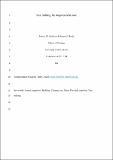Files in this item
Nest building, the forgotten behaviour
Item metadata
| dc.contributor.author | Guillette, Lauren Mary | |
| dc.contributor.author | Healy, Susan Denise | |
| dc.date.accessioned | 2016-11-02T00:33:38Z | |
| dc.date.available | 2016-11-02T00:33:38Z | |
| dc.date.issued | 2015-12 | |
| dc.identifier | 239971996 | |
| dc.identifier | a2e68438-5b3b-4c3f-ac33-6b5c11ce5e6d | |
| dc.identifier | 84946547339 | |
| dc.identifier | 000218452000015 | |
| dc.identifier.citation | Guillette , L M & Healy , S D 2015 , ' Nest building, the forgotten behaviour ' , Current Opinion in Behavioral Sciences , vol. 6 , pp. 90-96 . https://doi.org/10.1016/j.cobeha.2015.10.009 | en |
| dc.identifier.other | ORCID: /0000-0002-8059-4480/work/60631324 | |
| dc.identifier.uri | https://hdl.handle.net/10023/9748 | |
| dc.description | We thank the BBSRC (BB/I019502/1, SDH; Anniversary Future Leader Fellowship 163 BB/M013944/1, LMG) for funding. | en |
| dc.description.abstract | In the last decade tool manufacture in birds has transformed the landscape of animal cognition. As tool manufacture, however, is rare and practised by species that are not commonplace it is not a particularly useful model for investigating the evolution of physical cognition. On the basis of recent evidence, we argue that nest building, which bears considerable phenotypic resemblance to tool making, is more useful for examining not only the role that cognition may play in construction behaviours, but also the neural underpinning of those behaviours and, ultimately their evolution. We substantiate our view with recent evidence that building by birds involves changes in dexterity, is experience-dependent and involves activity in, at least, motor, reward and social network brain regions as well as in the cerebellum. | |
| dc.format.extent | 867330 | |
| dc.language.iso | eng | |
| dc.relation.ispartof | Current Opinion in Behavioral Sciences | en |
| dc.subject | Animal cognition | en |
| dc.subject | Building | en |
| dc.subject | Construction | en |
| dc.subject | Nests | en |
| dc.subject | Physical cognition | en |
| dc.subject | Tool making | en |
| dc.subject | QL Zoology | en |
| dc.subject | BF Psychology | en |
| dc.subject.lcc | QL | en |
| dc.subject.lcc | BF | en |
| dc.title | Nest building, the forgotten behaviour | en |
| dc.type | Journal article | en |
| dc.contributor.sponsor | BBSRC | en |
| dc.contributor.sponsor | BBSRC | en |
| dc.contributor.institution | University of St Andrews. School of Biology | en |
| dc.contributor.institution | University of St Andrews. Institute of Behavioural and Neural Sciences | en |
| dc.contributor.institution | University of St Andrews. Centre for Social Learning & Cognitive Evolution | en |
| dc.contributor.institution | University of St Andrews. Centre for Biological Diversity | en |
| dc.identifier.doi | https://doi.org/10.1016/j.cobeha.2015.10.009 | |
| dc.description.status | Peer reviewed | en |
| dc.date.embargoedUntil | 2016-11-01 | |
| dc.identifier.grantnumber | BB/I019502/1 | en |
| dc.identifier.grantnumber | BB/I019502/1 | en |
This item appears in the following Collection(s)
Items in the St Andrews Research Repository are protected by copyright, with all rights reserved, unless otherwise indicated.

